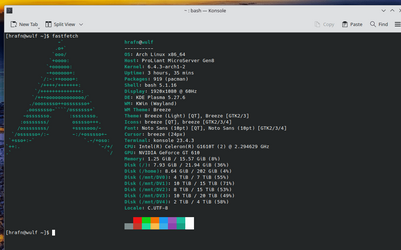Hi folks
@martyfelker and others interested : W11 VM's on KVM/QEMU
I've given up on 99% of other Linux distros now for using Windows VM's with KVM
Most of the current Windows VM's under KVM/QEMU fail because of problems with TPM (swtpm not working -- emulated TPM) or secure boot fails - wrong version of edmk (secure boot module --tianocore).
Arch Linux -- in spite of the fact you have to do more work on it - just runs every time and is totally up to date. No probs with W11 VM's on the host even on a really old host. Zero bloat too -- one of the few distros you can install a basic full featured GUI like KDE without all the zillions of bloat packages you don't want or use.
If you install KDE on Arch linux - without all the bloat -- just run pacman -S xorg plasma plasma-wayland-session. Also start the sddm session - KDE Window / GUI manager (systemctl enable sddm) before re-booting . Also a good idea to install openssh and enable sshd as well.
(Don't install the kde-applications package -- just individually install ones you ant -- konsole is pretty mandatory as is networkmanager !! and start it too -- syscntl enable NetworkManager before rebooting installed system).
Install Samba etc as you want -- but you get a really fast lean and mean system with a decent GUI not containing zillions of apps you don't want and don't use).
It's OK to use /dev/tpm0 if you want to passthru the tpm from the host -- but I like to run several VM's concurrently so the emulated TPM is the way togo -- with passthru obviously only 1 VM can have control of the physical hardware !!.
E.G -- just restored an Arch linux system over the Fedora 38 test system I had On Arch all working brilliantly again. Fedora 38 - KVM failed with tpm emulator after it;s latest set of updates. (Debian is also OK but only if you don't mind running "Not leading edge software" - but it's stable. Ubuntu etc irritate me beyond measure as they always want you to use flatpak or snap -- avoid those horrors at all costs !!.
Nice modern kernel ==> 6.4.3 also !! Note also only 919 packages on the system with most of the GUI things I need.

Cheers
jimbo
@martyfelker and others interested : W11 VM's on KVM/QEMU
I've given up on 99% of other Linux distros now for using Windows VM's with KVM
Most of the current Windows VM's under KVM/QEMU fail because of problems with TPM (swtpm not working -- emulated TPM) or secure boot fails - wrong version of edmk (secure boot module --tianocore).
Arch Linux -- in spite of the fact you have to do more work on it - just runs every time and is totally up to date. No probs with W11 VM's on the host even on a really old host. Zero bloat too -- one of the few distros you can install a basic full featured GUI like KDE without all the zillions of bloat packages you don't want or use.
If you install KDE on Arch linux - without all the bloat -- just run pacman -S xorg plasma plasma-wayland-session. Also start the sddm session - KDE Window / GUI manager (systemctl enable sddm) before re-booting . Also a good idea to install openssh and enable sshd as well.
(Don't install the kde-applications package -- just individually install ones you ant -- konsole is pretty mandatory as is networkmanager !! and start it too -- syscntl enable NetworkManager before rebooting installed system).
Install Samba etc as you want -- but you get a really fast lean and mean system with a decent GUI not containing zillions of apps you don't want and don't use).
It's OK to use /dev/tpm0 if you want to passthru the tpm from the host -- but I like to run several VM's concurrently so the emulated TPM is the way togo -- with passthru obviously only 1 VM can have control of the physical hardware !!.
E.G -- just restored an Arch linux system over the Fedora 38 test system I had On Arch all working brilliantly again. Fedora 38 - KVM failed with tpm emulator after it;s latest set of updates. (Debian is also OK but only if you don't mind running "Not leading edge software" - but it's stable. Ubuntu etc irritate me beyond measure as they always want you to use flatpak or snap -- avoid those horrors at all costs !!.
Nice modern kernel ==> 6.4.3 also !! Note also only 919 packages on the system with most of the GUI things I need.

Cheers
jimbo
Last edited:
My Computer
System One
-
- OS
- Windows XP,7,10,11 Linux Arch Linux
- Computer type
- PC/Desktop
- CPU
- 2 X Intel i7

















